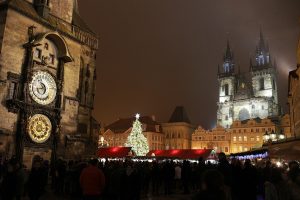In August 2002, Prague was flooded by heavy rains. The results were catastrophic; billions of Czech korunas’ worth of damage, seventeen dead, and forty thousand people evacuated from their homes.
In the aftermath, the resilient residents dusted themselves off and started to pick up the pieces. The owner of house number 1, on Haštalská street was one such inhabitant. A wall in his basement had collapsed. But the collapse wasn’t all bad news. It revealed long-forgotten, walled up secret passages and subterranean alchemy laboratories – now recognized as a UNESCO World Heritage site.
Ten years after its initial discovery, Speculum Alchemiae opened to the general public. As to be expected, the discovered space wasn’t perfectly preserved, so reconstructions had to be carried out. These followed original engravings and pictures from the 16th century. The space is now a mix of original and reproduction, but the subterranean passages and rooms are all authentic, allowing visitors to soak up the atmosphere of sixteenth century chemistry.
Speculum Alchemiae offers thirty minute tours of the subterranean laboratories. Luckily, when I visited, the tour group consisted of just my travel partner and I, and the very knowledgeable tour guide. It didn’t require much imagination to be transported back to times gone by; the quest for the philosopher’s stone, elixir of eternal youth and transmutation (turning metals into gold). The whole of foggy, gothic Prague lends itself to this transportation. Speculum Alchemiae is really just the cherry on the cake.
The laboratory is believed to have been built at the behest of Emperor Rudolf II – Holy Roman Emperor between 1576 to 1612, and a great alchemy devotee. Whilst living in Prague he encouraged Europe’s best alchemists to his court; men such as Edward Kelley, John Dee, Tycho de Brahe and Rabbi Loew. He is even known to have performed some alchemy experiments himself. The secret passages connect the laboratories to Prague Castle, the Old Town Hall and Barracks – allowing alchemists to travel unseen between the four locations.
The history is fascinating, but as a chemist I was just as drawn to the actual workings of the laboratory. There are three main rooms. The first is a drying room, where plants were stored and dried, to be used in elixirs. The second is where most of the magic happened; with apparatus for plant distillation and elixir blending, and a transmutation oven.

The third is a glass-blowing room; the alchemists made their own glass apparatus in order to be self-sufficient and avoid discovery. Oven exhaust was funneled through the house and out of its chimneys, as gases rising from under the streets would have been another sure route to discovery.

Speculum Alchemiae sells elixirs based on ancient documents found onsite. You can try your luck at eternal life, love or ‘drinkable gold’. Unfortunately there are good reasons why alchemy was replaced with modern chemistry, so the odds of these potions working aren’t in your favour. The visit, though, was definitely well worth it.
